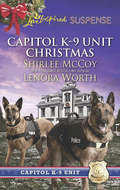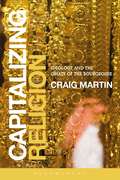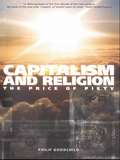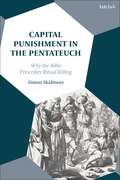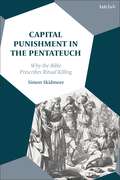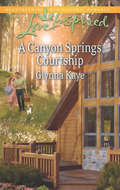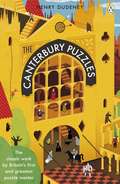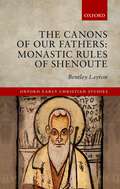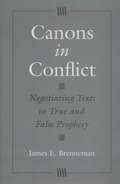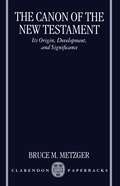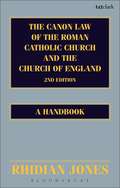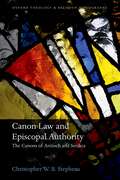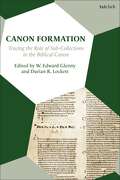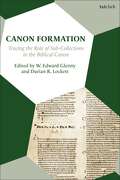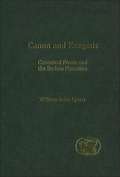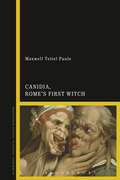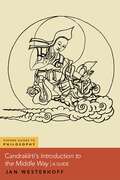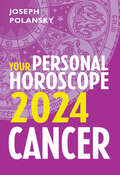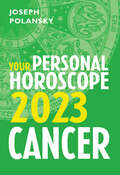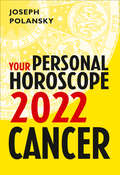- Table View
- List View
Capitol K-9 Unit Christmas: Protecting Virginia; Guarding Abigail (Mills And Boon Love Inspired Suspense Ser. #7)
by Lenora Worth Shirlee McCoyDANGER STRIKES AT CHRISTMASTIME
Capitalizing Religion: Ideology and the Opiate of the Bourgeoisie
by Craig MartinTalk of 'spirituality' and 'individual religion' is proliferating both in popular discourse and scholarly works. Increasingly people claim to be 'spiritual but not religious,' or to prefer 'individual religion' to 'organized religion.' Scholars have for decades noted the phenomenon - primarily within the middle class - of individuals picking and choosing elements from among various religious traditions, forming their own religion or spirituality for themselves. While the topics of 'spirituality' and 'individual religion' are regularly treated as self-evident by the media and even some scholars of religion, Capitalizing Religion provides one of the first critical analyses of the phenomenon, arguing that these recent forms of spirituality are in many cases linked to capitalist ideology and consumer practices. Examining cases such as Eckhart Tolle's The Power of Now, and Karen Berg's God Wears Lipstick, Craig Martin ultimately argues that so-called 'individual religion' is a religion of the status quo or, more critically, 'an opiate of the bourgeoisie.' Capitalizing Religion: Ideology and Opiate of the Bourgeoisie is a landmark publication in critical religious studies.
Capitalizing Religion: Ideology and the Opiate of the Bourgeoisie
by Craig MartinTalk of 'spirituality' and 'individual religion' is proliferating both in popular discourse and scholarly works. Increasingly people claim to be 'spiritual but not religious,' or to prefer 'individual religion' to 'organized religion.' Scholars have for decades noted the phenomenon - primarily within the middle class - of individuals picking and choosing elements from among various religious traditions, forming their own religion or spirituality for themselves. While the topics of 'spirituality' and 'individual religion' are regularly treated as self-evident by the media and even some scholars of religion, Capitalizing Religion provides one of the first critical analyses of the phenomenon, arguing that these recent forms of spirituality are in many cases linked to capitalist ideology and consumer practices. Examining cases such as Eckhart Tolle's The Power of Now, and Karen Berg's God Wears Lipstick, Craig Martin ultimately argues that so-called 'individual religion' is a religion of the status quo or, more critically, 'an opiate of the bourgeoisie.' Capitalizing Religion: Ideology and Opiate of the Bourgeoisie is a landmark publication in critical religious studies.
Capitalism and Religion: The Price of Piety
by Philip GoodchildOur global ecological crisis demands that we question the rationality of the culture that has caused it: western modernity's free market capitalism. Philip Goodchild develops arguments from Nietzsche, Adorno, Horkheimer, and Marx, to suggest that our love of Western modernity is an expression of a piety in which capitalism becomes a global religion, in practice, if not always in belief. This book presents a philosophical alternative that demands attention from philosophers, critical theorists, philosophers of religion, theologians, and those in ecological politics.
Capitalism and Religion: The Price of Piety
by Philip GoodchildOur global ecological crisis demands that we question the rationality of the culture that has caused it: western modernity's free market capitalism. Philip Goodchild develops arguments from Nietzsche, Adorno, Horkheimer, and Marx, to suggest that our love of Western modernity is an expression of a piety in which capitalism becomes a global religion, in practice, if not always in belief. This book presents a philosophical alternative that demands attention from philosophers, critical theorists, philosophers of religion, theologians, and those in ecological politics.
Capital Punishment in the Pentateuch: Why the Bible Prescribes Ritual Killing
by Simon SkidmoreThrough the application of mimetic theory Skidmore examines the social impact of capital punishment upon the community, and explores the cathartic nature of this practice within key Pentateuchal texts. Skidmore shows how Mimetic theorists such as Girard advance a view that a community ravaged by vengeance and blood feuds may be saved from extinction by scapegoating one of their own. As the community select a common scapegoat, and vent their collective violence upon this person, peace and order are restored. Though an in-depth analysis of various passages, Skidmore reveals this process in key Pentateuchal texts concerning capital punishment. These observations suggest that biblical capital punishment may have functioned as a means of protecting the Israelite community by managing rivalry and violence.
Capital Punishment in the Pentateuch: Why the Bible Prescribes Ritual Killing
by Simon SkidmoreThrough the application of mimetic theory Skidmore examines the social impact of capital punishment upon the community, and explores the cathartic nature of this practice within key Pentateuchal texts. Skidmore shows how Mimetic theorists such as Girard advance a view that a community ravaged by vengeance and blood feuds may be saved from extinction by scapegoating one of their own. As the community select a common scapegoat, and vent their collective violence upon this person, peace and order are restored. Though an in-depth analysis of various passages, Skidmore reveals this process in key Pentateuchal texts concerning capital punishment. These observations suggest that biblical capital punishment may have functioned as a means of protecting the Israelite community by managing rivalry and violence.
A Canyon Springs Courtship
by Glynna KayeCouncilman Jake Talford is determined to protect his small Arizona town. Even if that means keeping a close eye on former sweetheart Macy Colston.
The Canterbury Puzzles
by Henry DudeneyFor the mastermind who has what it takes to solve the tricky conundrums from Britain's first and greatest puzzle master.---------------------------------------Solve the puzzle of The Mystery of Ravensdene Park . . . trace the route of the butler, the gamekeeper and the two anonymous guests and the key to the mystery will reveal itself.---------------------------------------Decipher the riddle of The Frogs' Ring for The Merry Monks of Riddlewell . . . ---------------------------------------At The Squire's Christmas Puzzle Party ascertain just how many kisses had been given Under the Mistletoe Bough . . . ---------------------------------------First published in 1907, Dudeney's The Canterbury Puzzles is a classic of the genre, based on characters from Chaucer's Tales. The book contains 114 puzzles suitable for young enthusiasts, recreational mathematicians and veteran puzzlers alike. As challenging today as it was over a century ago, this ingenious book will provide hours-worth of puzzles to keep your brain alert."Regular exercise is supposed to be as necessary for the brain as for the body. Many of us are very apt to suffer from mental cobwebs, and there is nothing equal to the solving of puzzles for sweeping them away." - Henry Dudeney (1847-1930)
The Canons of Our Fathers: Monastic Rules of Shenoute (Oxford Early Christian Studies)
by Bentley LaytonThis book is the first publication of a very early set of Christian monastic rules from Roman Egypt, accompanied by four preliminary chapters discussing their historical and social context and their character as rules. These rules were found quoted in the writings of the great Egyptian monastic leader Shenoute. Designed for a federation of monks and nuns who banded together about 360 CE—forming the so-called "White Monastery Federation"—the rules date back to the fourth and fifth centuries. New historical evidence is presented for the founding of the Federation. Providing almost the earliest evidence for Christian communal (cenobitic) monasticism, the rules depict many intimate aspects of ascetic practice. Details of monastic daily life are mentioned in passing in the rules, and the author uses these details to describe their picture of monastic life under five general topics: the monastery as a physical plant, the human makeup of the community, ascetic observances, the hierarchy of authority, and the daily liturgy. The book includes a clear English translation of the rules accompanied by the original Coptic text, amounting to five hundred and ninety-five entries.
Canons in Conflict: Negotiating Texts in True and False Prophecy
by James E. BrennemanIn this new study, James Brenneman confronts the issue of conflicting canons with full force, incorporating insights gained from both literary and biblical disciplines on the question of canon. He begins with an illuminating tour through contemporary literary theory from Hans Robert Jauss to Stanley Fish, and current discussions in theology about the canon. He goes on to a consideration of true and false prophesy, with a detailed examination of the three apparently conflicting versions of the Old Testament "swords into plowshares" prophesy, as found in Isaiah 2:2-4,5; Joel 4:9-12 (Eng. 3:9-12); and Micah 4:1-5. Suggesting that the dynamics controlling the process for negotiating between contradictory readings of prophetic texts are the same as those at work in adjudicating between canons in conflict, Brenneman concludes by pointing the way towards an integrative approach appropriate to the question of canon and authority in a "post-modern" pluralistic context.
The Canon of the New Testament: Its Origin, Development, and Significance
by Bruce M. MetzgerThis book provides information from Church history concerning the recognition of the canonical status of the several books of the New Testament. Canonization was a long and gradual process of sifting among scores of gospels, epistles, and other books that enjoyed local and temporary authority - some of which have only recently come to light among the discoveries of Nag Hammadi. After discussing the external pressures that led to the fixing of the limits of the canon, the author gives sustained attention to Patristic evidence that bears on the development of the canon not only in the West but also among the Eastern Churches, including the Syrian, Armenian, Georgian, Coptic, and Ethiopian. Besides considering differences as to the sequence of the books in the New Testament, Dr Metzger takes up such questions as which form of text is to be regarded as canonical; whether the canon is open or closed; to what extent a canon should be sought within the canon; and whether the canon is a collection of authoritative books or an authoritative collection of books.
The Canon Law of the Roman Catholic Church and the Church of England 2nd edition: A Handbook
by Rhidian JonesA thoroughly revised and updated standard work on the Canon law of the Roman Catholic Church and the Church of England.
The Canon Law of the Roman Catholic Church and the Church of England 2nd edition: A Handbook
by Rhidian JonesA thoroughly revised and updated standard work on the Canon law of the Roman Catholic Church and the Church of England, this work now includes a list of Eastern Catholic Churches which are fully Catholic in so far as they are in full communion with the Roman pontiff. On the Anglican side, there is a list of Churches which comprise the Anglican Communion, and the changes brought about by the Churchwardens Measure (2001), the Clergy Discipline Measure (2003) and Ecclesiastical Offices (Terms of Service) Measure (2009) have been included.
Canon Law and Episcopal Authority: The Canons of Antioch and Serdica (Oxford Theology and Religion Monographs)
by Christopher W. StephensChristopher Stephens focuses on canon law as the starting point for a new interpretation of divisions between East and West in the Church after the death of Constantine the Great. He challenges the common assumption that bishops split between 'Nicenes' and 'non-Nicenes', 'Arians' or 'Eusebians'. Instead, he argues that questions of doctrine took second place to disputes about the status of individual bishops and broader issues of the role of ecclesiastical councils, the nature of episcopal authority, and in particular the supremacy of the bishop of Rome. Canon law allows the author to offer a fresh understanding of the purposes of councils in the East after 337 particularly the famed Dedication Council of 341 and the western meeting of the council of Serdica and the canon law written there, which elevated the bishop of Rome to an authority above all other bishops. Investigating the laws they wrote, the author describes the power struggles taking place in the years following 337 as bishops sought to elevate their status and grasp the opportunity for the absolute form of leadership Constantine had embodied. Combining a close study of the laws and events of this period with broader reflections on the nature of power and authority in the Church and the increasingly important role of canon law, the book offers a fresh narrative of one of the most significant periods in the development of the Church as an institution and of the bishop as a leader.
Canon Formation: Tracing the Role of Sub-Collections in the Biblical Canon
by W. Edward Glenny and Darian R. LockettContributors to this volume examine the various collections of canonical sub-units in the canon, considering the state of the question regarding each particular collection. The chapters introduce the issues involved in sub-collections being accepted in the canon, summarize the historical evidence of the acceptance of these collections, and discuss the compositional evidence of “canonical consciousness” in the various collections. The contributors consider paratextual evidence, for example, the arrangement of the books in various manuscripts, the titles of the books, and also include evidence such as the presence of catchwords, framing devices, and themes.The book begins with a consideration of the two overarching collections – the Old and New Testaments. Next, several sub-collections within the Hebrew Bible (OT) are considered, including the Torah, Prophets, the Megilloth, the Twelve (both in their Masoretic Text and Septuagint forms), and the Psalter. In addition, sub-collections in the New Testament include the four-fold Gospel, the Pauline Collection (usually with Hebrews in the early manuscripts), the function of Acts within the New Testament, the Praxapostolos (Acts along with the Catholic Epistles), and the function of Revelation as the end of the canon.
Canon Formation: Tracing the Role of Sub-Collections in the Biblical Canon
Contributors to this volume examine the various collections of canonical sub-units in the canon, considering the state of the question regarding each particular collection. The chapters introduce the issues involved in sub-collections being accepted in the canon, summarize the historical evidence of the acceptance of these collections, and discuss the compositional evidence of “canonical consciousness” in the various collections. The contributors consider paratextual evidence, for example, the arrangement of the books in various manuscripts, the titles of the books, and also include evidence such as the presence of catchwords, framing devices, and themes.The book begins with a consideration of the two overarching collections – the Old and New Testaments. Next, several sub-collections within the Hebrew Bible (OT) are considered, including the Torah, Prophets, the Megilloth, the Twelve (both in their Masoretic Text and Septuagint forms), and the Psalter. In addition, sub-collections in the New Testament include the four-fold Gospel, the Pauline Collection (usually with Hebrews in the early manuscripts), the function of Acts within the New Testament, the Praxapostolos (Acts along with the Catholic Epistles), and the function of Revelation as the end of the canon.
Canon and Exegesis: Canonical Praxis and the Sodom Narrative (The Library of Hebrew Bible/Old Testament Studies)
by William John LyonsPrevious attempts to critique the canonical approach of Brevard Childs have remained largely theoretical in nature. One of the weakness of canonical criticism, then, is its failure to have generated new readings of extended biblical passages. Reviewing the hermeneutics and the praxis of Childs' approach, Lyons then turns to the Sodom narrative (Gen 18-19) as a test of a practical exegesis according to Childs' principles, and then to reflect critically upon the reading experience generated. Surprisingly, the canonical reading produced is a wholly new one, centred around the complex, irreducible-even contradictory-request of Abraham for Yahweh to do justice (18:23-25).
Canidia, Rome’s First Witch
by Maxwell Teitel PauleCanidia is one of the most well-attested witches in Latin literature. She appears in no fewer than six of Horace's poems, three of which she has a prominent role in. Throughout Horace's Epodes and Satires she perpetrates acts of grave desecration, kidnapping, murder, magical torture and poisoning. She invades the gardens of Horace's literary patron Maecenas, rips apart a lamb with her teeth, starves a Roman child to death, and threatens to unnaturally prolong Horace's life to keep him in a state of perpetual torment. She can be seen as an anti-muse: Horace repeatedly sets her in opposition to his literary patron, casts her as the personification of his iambic poetry, and gives her the surprising honor of concluding not only his Epodes but also his second book of Satires. This volume is the first comprehensive treatment of Canidia. It offers translations of each of the three poems which feature Canidia as a main character as well as the relevant portions from the other three poems in which Canidia plays a minor role. These translations are accompanied by extensive analysis of Canidia's part in each piece that takes into account not only the poems' literary contexts but their magico-religious details.
Canidia, Rome’s First Witch
by Maxwell Teitel PauleCanidia is one of the most well-attested witches in Latin literature. She appears in no fewer than six of Horace's poems, three of which she has a prominent role in. Throughout Horace's Epodes and Satires she perpetrates acts of grave desecration, kidnapping, murder, magical torture and poisoning. She invades the gardens of Horace's literary patron Maecenas, rips apart a lamb with her teeth, starves a Roman child to death, and threatens to unnaturally prolong Horace's life to keep him in a state of perpetual torment. She can be seen as an anti-muse: Horace repeatedly sets her in opposition to his literary patron, casts her as the personification of his iambic poetry, and gives her the surprising honor of concluding not only his Epodes but also his second book of Satires. This volume is the first comprehensive treatment of Canidia. It offers translations of each of the three poems which feature Canidia as a main character as well as the relevant portions from the other three poems in which Canidia plays a minor role. These translations are accompanied by extensive analysis of Canidia's part in each piece that takes into account not only the poems' literary contexts but their magico-religious details.
Candrak?rti's Introduction to the Middle Way: A Guide (OXFORD GUIDES TO PHILOSOPHY SERIES)
by Jan WesterhoffCandrak?rti's Introduction to the Middle Way (Madhyamak?vat?ra) is a central work of Buddhist philosophy for two reasons. First, it provides an introduction to Madhyamaka, one of the three major philosophical schools of Buddhist thought (the other two being Abhidharma and Yog?c?ra). Second, within Madhyamaka, Candrak?rti's text occupies a very prominent role. This is primarily due to its enormous influence in Tibet, where Candrak?rti's work became the main entry-point into the study of Madhyamaka thought. While the historical importance of the Introduction to the Middle Way for understanding a major section of Buddhist thought is evident, what makes it particularly interesting for students is the role it plays as an 'introduction'. It is one of Candrak?rti's earlier works and presents a comprehensive guide to the key philosophical ideas and problems of Madhyamaka thought. This Oxford Guide is for the philosophically interested student or scholar reading the Introduction to the Middle Way. Westerhoff's commentary focuses on the philosophical content of the text, using Candrak?rti's auto-commentary as the main explicatory resource.
Candrak?rti's Introduction to the Middle Way: A Guide (OXFORD GUIDES TO PHILOSOPHY SERIES)
by Jan WesterhoffCandrak?rti's Introduction to the Middle Way (Madhyamak?vat?ra) is a central work of Buddhist philosophy for two reasons. First, it provides an introduction to Madhyamaka, one of the three major philosophical schools of Buddhist thought (the other two being Abhidharma and Yog?c?ra). Second, within Madhyamaka, Candrak?rti's text occupies a very prominent role. This is primarily due to its enormous influence in Tibet, where Candrak?rti's work became the main entry-point into the study of Madhyamaka thought. While the historical importance of the Introduction to the Middle Way for understanding a major section of Buddhist thought is evident, what makes it particularly interesting for students is the role it plays as an 'introduction'. It is one of Candrak?rti's earlier works and presents a comprehensive guide to the key philosophical ideas and problems of Madhyamaka thought. This Oxford Guide is for the philosophically interested student or scholar reading the Introduction to the Middle Way. Westerhoff's commentary focuses on the philosophical content of the text, using Candrak?rti's auto-commentary as the main explicatory resource.
Cancer 2024: Your Personal Horoscope
by Joseph PolanskyYour complete one-volume guide to the year 2024. This fantastic and in-depth book includes month-by-month forecasts for every sign and all you need to know to find out what is in store for you in the year ahead. The only one-volume horoscope you’ll ever need.
Cancer 2023: Your Personal Horoscope
by Joseph PolanskyYour complete one-volume guide to the year 2023. This fantastic and in-depth book includes month-by-month forecasts for every sign and all you need to know to find out what is in store for you in the year ahead. The only one-volume horoscope you’ll ever need.
Cancer 2022: Your Personal Horoscope
by Joseph PolanskyYour guide to the year 2022. This fantastic book includes month-by-month forecasts and all you need to know to find out what is in store for you in the year ahead. The only horoscope you’ll ever need.
